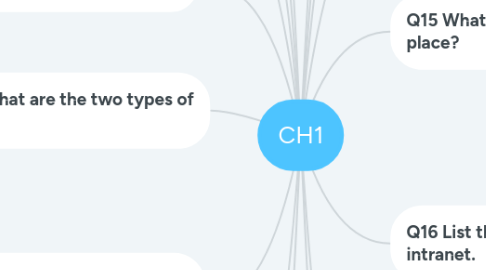
1. 1)List the three main digital opportunities.
1.1. • Reach
1.1.1. – Over 1 billion users globally
1.1.2. – Connect to millions of products
1.2. • Richness
1.2.1. – Detailed product information on 20 billion+ pages indexed by Google. Blogs, videos, feeds…
1.2.2. – Personalised messages for users
1.2.3. – Variety of available information/products/services.
1.3. • Affiliation
1.3.1. Ease of co-operation
1.3.2. Partnerships are key in the networked economy.
2. What is meant by E-business risks?
2.1. • Making wrong decision about e-business investments
2.2. • Provide poor online customer experience
3. Define E-business?
3.1. A broader definition of EC that includes not just the buying and selling of goods and services, but also servicing customers, collaborating with business partners, and conducting electronic transactions within an organization
4. Q4 Define E-Commerce?
4.1. • The process of buying, selling, or exchanging products, services, or information via Internet
5. Q5 Define Digital Business?
5.1. • How businesses apply digital technology and media to improve the competitiveness of their organization through optimizing internal processes with online and traditional channels to market and supply.
6. Q6 What are the two types of risks?
6.1. • Strategic risks
6.1.1. making wrong decisions about e-business investments
6.2. • practical risks
6.2.1. bad stories which may lead to change the company reputation
7. Q7 What are the four perspectives of E-Commerce definition?
7.1. 1. A communications perspective
7.1.1. the delivery of information, products or services or payment by electronic means.
7.2. 2. A business process perspective
7.2.1. the application of technology towards the automation of business transactions and workflows
7.3. 3. A service perspective
7.3.1. enabling cost cutting at the same time as increasing the speed and quality of service delivery.
7.4. 4. An online perspective
7.4.1. the buying and selling of products and information online.
8. Q8 Distinguish between
8.1. • Buy-side e-commerce
8.1.1. E-commerce transactions between a purchasing organization and its suppliers.
8.2. • Sell-side e-commerce
8.2.1. E-commerce transactions between a supplier organization and its customers.
8.2.1.1. Q11 List the different types of sell-side e-commerce.
8.2.1.1.1. 1. Transaction e-commerce site.
8.2.1.1.2. 2. Services-oriented relationship-building web site.
8.2.1.1.3. 3. Brand-building site.
8.2.1.1.4. 4. Portal or media site.
9. Q10 List some issues involved in digital marketing.
9.1. • Insufficient bandwidth
9.2. • Poor Security
9.3. • lack of Trust that could be a vital factor in digital business
9.4. • a remarkable source of competition for businesses
10. Q12 What is meant by inbound marketing?
10.1. The consumer is proactive in actively seeking out information for their needs, and interactions with brands are attracted through content, search and social media marketing. (FACEBOOK)
11. Q13 What is meant by zero moment of truth?
11.1. (ZMOT): A summary of today’s multichannel consumer decision-making for product purchase where they search, review ratings, styles, prices and comments on social media before visiting a retailer.
12. Q14 What is meant by content marketing?
12.1. The management of text, rich media, audio and video content aimed at engaging customers and prospects to meet business goals, published through print and digital media including web and mobile platforms, which is repurposed and syndicated to different forms of web presence such as publisher sites, blogs, social media and comparison sites.
13. Q15 What is meant by E-market place?
13.1. An online marketplace where buyers and sellers meet to exchange goods, services, money, or information
14. Q16 List the main benefits of intranet.
14.1. 1. Improved information sharing (customer service), 97%
14.2. 2. Enhanced communications and information sharing (communications), 95%
14.3. 3. Increased consistency of information (customer service), 94%
14.4. 4. Increased accuracy of information (customer service), 93%
14.5. 5. Reduced or eliminated processing, 93%
14.6. 6. Easier organizational publishing, 92%.
15. Q17 List some E-commerce models.
15.1. • • Traditional:
15.1.1. • – B2C: Business to consumer
15.1.2. • – B2B: Business to business
15.2. • • New:
15.2.1. • – C2C: Consumer to consumer
15.2.2. • – C2B: Consumer to business
15.3. • – Also:
15.3.1. • – G2C: Government to consumer
15.3.2. • – G2B: Government to business
15.3.3. • – G2G: Government to government
15.4. • Meta E- Business
15.5. • Intra-Organisation E-Business
15.6. • Others – P2P etc.
16. Q18 Define SCM.
16.1. The coordination of all supply activities of an organization from its supplier and partners to its customers
17. Q20 List some digital business adoption drivers.
17.1. • Cost/efficiency drivers
17.1.1. – Increasing speed with which supplies can be obtained
17.1.2. – Increasing speed with which goods can be dispatched
17.1.3. – Reduced sales and purchasing costs
17.1.4. – Reduced operating costs.
17.2. • Competitiveness drivers
17.2.1. – Customer demand
17.2.2. – Improving the range and quality of services offered
17.2.3. – Avoid losing market share to businesses already using e-commerce.
